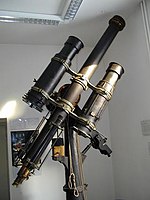
Back مرسام فلكي Arabic Astroqraf Azerbaijani Астрограф Byelorussian Astrògraf Catalan ئاسترۆگراف CKB Astrograf German Astrógrafo Spanish Astrograaf Estonian اخترنگار Persian Astrographe French
This article needs additional citations for verification. (May 2014) |




An astrograph (or astrographic camera) is a telescope designed for the sole purpose of astrophotography. Astrographs are mostly used in wide-field astronomical surveys of the sky and for detection of objects such as asteroids, meteors, and comets.
Improvements in photography in the middle 19th century led to designs dedicated to astrophotography, and they were also popular in the 20th century. As in other photography, chemicals were used that respond to light, recorded on a glass photographic plate or sometimes on photographic film. Many observatories of this period used an astrograph, beside instruments like the transit telescope, great refractors, and chronometers, or instruments for observing the Sun.
Astrographs were often used to make surveys of the night sky, and one of the famous projects was Carte du Ciel. Discoveries using an astrograph include then-planet Pluto. Rather than looking through the telescope, it was discovered by using a blink comparator with images taken by an astrograph.
By the late 20th century, electronic detectors became more common with the data being stored electronically.
- ^ Tombaugh, Clyde (5 April 1995). The Struggles to Find the Ninth Planet. NASA/JPL Outer Planets/Solar Probe Project, 5 April 1995. Retrieved from http://ircamera.as.arizona.edu/NatSci102/NatSci102/text/ext9thplanet.htm.
© MMXXIII Rich X Search. We shall prevail. All rights reserved. Rich X Search